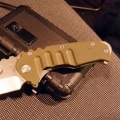The Art and Craftsmanship of Handmade Knives: How are they Made
Introduction
Handmade knives are a true testament to the artistry and skill of their makers. Crafted with precision and dedication, these knives offer a level of quality and uniqueness that is unmatched by mass-produced counterparts. In this article, we will explore the fascinating process of making handmade knives and the craftsmanship involved.
Selecting the Right Steel
One of the most crucial steps in creating a handmade knife is selecting the right steel. The choice of steel affects the knife's performance, durability, and overall quality. High-carbon steel, such as 1095 or D2, is often preferred due to its excellent edge retention and toughness.
Forging the Blade
Forging is the process of shaping the blade by heating the steel and hammering it into the desired shape. Skilled blacksmiths use traditional forging techniques to create the blade's profile and establish its basic structure. The blade is then carefully heat-treated to enhance its hardness and edge retention.
Grinding and Shaping
After the blade has been forged, it undergoes grinding and shaping to refine its shape and create the bevels. This process involves using grinding wheels and belts of varying grits to remove excess material and achieve the desired thickness and edge geometry.
Heat Treatment
Heat treatment is a critical step that determines the hardness, toughness, and overall performance of the knife. The blade is heated to a specific temperature and then rapidly cooled to achieve the desired metallurgical properties. This process, known as quenching, helps the knife hold its edge and resist wear.
Handle Making
The handle is an essential component of a handmade knife, providing comfort, grip, and aesthetic appeal. Handles can be crafted from various materials, such as wood, bone, or synthetic composites. The chosen material is shaped and fitted to the tang of the blade, ensuring a secure and ergonomic handle design.
Finishing and Polishing
Once the blade and handle have been assembled, the knife undergoes finishing and polishing to enhance its appearance and functionality. This step involves sanding the surfaces to remove any imperfections, followed by buffing and polishing to achieve a smooth and lustrous finish.
Sharpening the Blade
The final step in making a handmade knife is sharpening the blade to achieve a razor-sharp edge. This process involves using sharpening stones or abrasive belts to refine the edge geometry and create a keen cutting edge. Skilled knife makers take great care to ensure the blade is sharpened to perfection.
Conclusion
The art and craftsmanship of handmade knives are a labor of love. From selecting the right steel to the final sharpening, every step in the process requires skill, precision, and attention to detail. The result is a unique and functional piece of art that reflects the dedication and passion of its maker.
FAQ
Q: How long does it take to make a handmade knife?
A: The time required to make a handmade knife varies depending on factors such as the complexity of the design, the level of craftsmanship, and the availability of tools and materials. On average, it can take several hours to several days or even weeks to complete a single knife.
Q: What are the advantages of handmade knives over mass-produced knives?
A: Handmade knives offer several advantages over mass-produced knives. They are often made from higher-quality materials, crafted with greater attention to detail, and customized to meet specific preferences. Handmade knives also have a unique character and individuality that sets them apart.
Q: Are handmade knives suitable for everyday use?
A: Yes, handmade knives are designed to be functional and durable. While they may be considered works of art, they are also meant to be used for various tasks, such as cutting, slicing, and chopping. However, proper care and maintenance are essential to ensure their longevity and performance.
Q: Can I customize a handmade knife?
A: Yes, many knife makers offer customization options to suit individual preferences. From blade designs and handle materials to decorative elements, customization allows you to create a knife that meets your specific needs and reflects your personal style.
Q: Are handmade knives more expensive than mass-produced knives?
A: Handmade knives tend to be more expensive than mass-produced knives due to the craftsmanship involved and the use of high-quality materials. The level of skill, time, and attention to detail invested in creating a handmade knife contributes to its higher price tag







Leave Reply